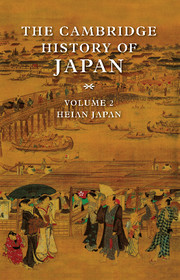Book contents
- Frontmatter
- Introduction
- 1 The Heian court, 794–1070
- 2 The capital and its society
- 3 Land and society
- 4 Provincial administration and land tenure in early Heian
- 5 Chinese learning and intellectual life
- 6 Aristocratic culture
- 7 Aristocratic Buddhism
- 8 Religious practices
- 9 Insei
- 10 The rise of the warriors
- Works cited
- Glossary-index
- Japan in the Heian period"
Introduction
Published online by Cambridge University Press: 28 March 2008
- Frontmatter
- Introduction
- 1 The Heian court, 794–1070
- 2 The capital and its society
- 3 Land and society
- 4 Provincial administration and land tenure in early Heian
- 5 Chinese learning and intellectual life
- 6 Aristocratic culture
- 7 Aristocratic Buddhism
- 8 Religious practices
- 9 Insei
- 10 The rise of the warriors
- Works cited
- Glossary-index
- Japan in the Heian period"
Summary
The Heian period opened in 794 with the building of a new capital, Heian-kyō, later known as Kyoto. The grand plan of the new city, on a larger scale than earlier capitals, expressed the ambitious vision of Emperor Kammu. No other Japanese emperor had ever taken into his own hands so decisively the absolute powers of the emperor as conceived in Chinese theory. He and some of his immediate successors not only asserted the authority of the throne; they took positive measures designed to improve the effectiveness of the central government in administering the country. Theirs was a dedicated attempt to revitalize the system of administration modeled on the governmental machinery of T'ang China and operate it effectively. Throughout the four centuries of the Heian era the imperial court continued as the only political center, but the effectiveness of its administration declined gradually. The title of emperor continued in the imperial line without dynastic change, as it does to this day, but many of the reigning emperors were reduced to figureheads, manipulated by noble families at court, notably the Fujiwara, and later by senior retired emperors. The Heian period closed in 1185 when the struggle for hegemony among the warrior families resulted in the victory of Minamoto no Yoritomo and most political initiatives devolved into his hands at his headquarters at Kamakura. The imperial court continued at Kyoto, playing a largely ceremonial and legitimizing role, while political power was exercised by military overlords until the Meiji Restoration of 1868.
During Heian times, however, there was no challenge to the central position of the imperial court; rather, there was a gradual decline in its ability to derive adequate income from the provinces to sustain itself in the style it had designed.
- Type
- Chapter
- Information
- The Cambridge History of Japan , pp. 1 - 19Publisher: Cambridge University PressPrint publication year: 1999
- 3
- Cited by

